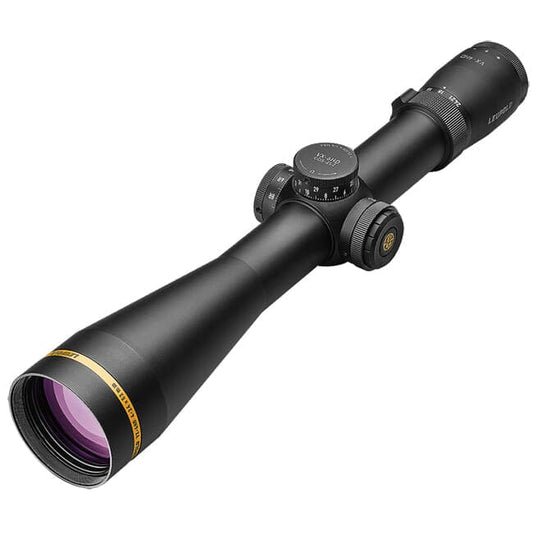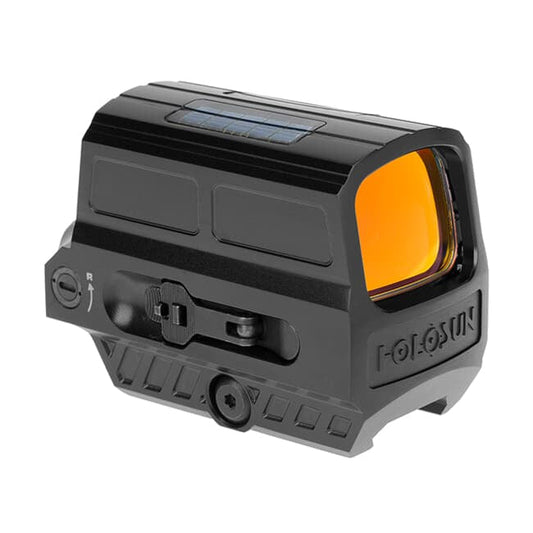Exploring Different Scope Reticle Types: Which is Right for You?
Imagine yourself out in the wilderness, rifle in hand. The cool wind rustles the leaves, and you're in pursuit of your quarry. But wait! There's a critical component to your shooting success that often gets overlooked: the reticle.
You've heard about them, those tiny designs you see when peering through your rifle scope. While they might seem insignificant, reticles are the key to accurate shooting. But, here's the million-dollar question: which type is right for you?
Well, buckle up, my friend! Today, we're going on a fascinating journey to explore the different types of scope reticles, their uses, and how to choose the one that best suits your needs.
Which Scope Reticle Is Best For You?
Understanding Reticles: A Brief Overview
Let's take a moment to understand reticles better. When you peer into your scope, those markings – whether they are dots, lines, or crosshairs – are what we call reticles. Their primary function? To guide your aim and enhance your shooting precision.
According to a study by Jones et al., 2017, a well-matched reticle to a shooter's needs can significantly improve the shooting outcome. So, it's safe to say that understanding the type of reticle you're using isn't just fun trivia – it can be a game-changer for your shooting accuracy.
Choosing the perfect reticle may seem daunting with so many options available. However, each type serves specific shooting scenarios, be it hunting, tactical shooting, or target practice. This post will break down those types, helping you determine which reticle is your perfect shooting companion.
Reticle Types: Exploring the Options
If we compare the reticle market to a buffet, we've got a wide spread of delicacies. From simple crosshairs to advanced grid systems, there's a reticle for every taste. Feeling a bit overwhelmed by the choices? That's understandable! Let's explore the different reticle types and their unique features:
- Duplex Reticle
- Mil-Dot Reticle
- BDC Reticle
- Illuminated Reticle
- MOA Reticle
- Christmas Tree Reticle
- Horus Reticle
Don't worry if you don't recognize all these names. We're about to dive into each one. Remember, finding the perfect reticle is like finding a shoe that fits just right – it's all about your comfort and needs.
Duplex Reticle: Simplicity and Versatility
The Duplex reticle is a staple in the world of shooting, a classic if you will. It's like the basic white shirt of reticles – simple, versatile, and always reliable. Picture crosshairs that thicken toward the edge of the scope, effortlessly directing your eyes to the center.
This straightforward design makes duplex reticles an excellent choice for hunting or casual target shooting. Particularly in environments with a cluttered background, the duplex shines, guiding your focus precisely where it needs to be.
In a 2019 study by the National Shooting Sports Foundation, duplex reticles were the most preferred by hunters, with 73% of respondents opting for them. But, while it's a popular choice, is it the right choice for you? Read on, and let's find out.
Mil-Dot Reticle: Precision and Range Estimation
Let's step it up a notch with the Mil-Dot reticle. The Mil-Dot reticle is the Swiss Army Knife of reticles, offering more than just basic functionality. Dots span the crosshairs, serving as reference points for range estimation and bullet drop compensation.
Precision is the Mil-Dot's middle name. With the dots as a reference, you can make accurate adjustments for bullet drop over distance and even wind drift. Now, that's a reticle pulling out all the stops to improve your shooting accuracy.
Noted shooting expert and author, Wayne van Zwoll, states that "Mil-Dot reticles have revolutionized long-range shooting". They're widely used in tactical and long-range shooting scenarios. If you're a shooter seeking precision and complexity, this reticle might just be your perfect match. But what about those needing help with bullet drop? We've got just the thing.
BDC Reticle: Bullet Drop Compensation Made Easy
Meet the BDC (Bullet Drop Compensation) reticle, your trusty assistant in counteracting bullet drop over distance. If you often shoot over varying distances and want a reticle that keeps up with your needs, the BDC reticle is your go-to choice.
This type of reticle features additional horizontal lines or dots under the center crosshair, each representing a certain distance. This way, you can aim using the line that corresponds to the distance of your target without the need to adjust your scope.
Renowned shooter and firearms instructor, Ken Hackathorn, notes, "BDC reticles have truly made long-distance shooting accessible to a broader audience." But remember, while a BDC reticle can simplify things, it is most effective when used with the cartridge it was designed for.
Illuminated Reticle: Enhancing Visibility in Low Light Conditions
If you've ever found yourself struggling to aim in low light, the illuminated reticle might just be your new best friend. This type of reticle uses battery-powered illumination to light up the reticle design, giving you better contrast against dark backgrounds.
It's like having a flashlight guiding your aim when you need it the most. Whether you're hunting at dawn or dusk or engaging in a tactical scenario with limited light, an illuminated reticle can make a world of difference.
Shooting consultant, Barry Dueck, says, "In low light conditions, an illuminated reticle can be the difference between making the shot and going home empty-handed." So, if you often find yourself shooting under less than optimal light conditions, the illuminated reticle could be the answer to your prayers.
MOA Reticle: Minute of Angle for Precise Adjustments
Next up, we have the MOA (Minute of Angle) reticle, a popular choice among long-distance and competitive shooters. MOA reticles offer precise incremental adjustment, helping you fine-tune your aim like never before.
Imagine having a ruler that helps you measure and make precise corrections. That's essentially what an MOA reticle does. The term "minute of angle" refers to 1/60th of an angle degree, which at 100 yards equates to about 1 inch.
According to professional shooter, Julie Golob, "An MOA reticle is like having a built-in measuring tape in your scope." While this precision can be incredibly helpful, keep in mind that it also requires a solid understanding of how MOA works.
Christmas Tree Reticle: Advanced Holdover and Windage Corrections
The Christmas tree reticle is a relatively new addition to the reticle family but has quickly gained popularity among long-range shooters. Named for its unique shape that resembles a Christmas tree, this reticle type offers advanced holdover and windage correction possibilities.
This reticle is like having a comprehensive road map that not only shows you the distance but also the potential wind effects on your bullet's trajectory. It's no wonder that long-range shooting enthusiasts often rave about it!
Veteran competitive shooter, Brian Litz, notes, "A Christmas tree reticle can seem overwhelming at first, but once you understand how to use it, it can drastically improve your long-range accuracy." If you're a fan of precision and don't mind complexity, this could be your match made in heaven.
Horus Reticle: Long-Range Shooting and Tactical Applications
Last but not least in our reticle repertoire is the Horus reticle. This reticle type is a favorite among the tactical community and long-range shooting aficionados. It features a detailed grid system that allows for advanced holdover and windage calculations without manual adjustments.
The Horus reticle is like the high-tech gadget of the reticle world, offering advanced capabilities for those who know how to utilize them. As former Navy SEAL and firearms trainer, Chris Sajnog, says, "The Horus reticle is a powerful tool for those who need to make quick, precise shots at varying distances."
Choosing the Right Reticle for Hunting
When it comes to hunting, choosing the right reticle can make all the difference. You want something that can adapt to varying distances and lighting conditions. For most hunters, a duplex or BDC reticle tends to be a reliable choice.
Consider your hunting environment and the typical distances to your targets. Do you often find yourself in low light conditions? An illuminated reticle might be worth considering. Remember, the best reticle for you is the one that meets your specific needs and preferences.
Selecting the Ideal Reticle for Target Shooting
Target shooting demands precision, and therefore, your choice of reticle should facilitate this. MOA and Mil-Dot reticles, with their incremental markings, can be excellent choices for the target shooter.
Again, consider your shooting range and conditions. Are you primarily a long-range shooter? The advanced features of a Christmas tree or Horus reticle might give you the edge you need. Always align your reticle choice with your shooting style and environment.
Tactical Reticles: Finding the Perfect Fit for Your Needs
Tactical shooting scenarios often require quick target acquisition and the ability to adjust for varying distances and windage quickly. Therefore, a reticle that offers holdover points and windage corrections, like the Horus or Christmas tree reticle, can be invaluable.
Remember, tactical situations often involve high-stress environments. Choose a reticle you're comfortable with and fully understand. A well-understood simple reticle can be more beneficial than a complex one used incorrectly.
Factors to Consider When Choosing a Reticle
Choosing a reticle is like choosing the perfect pair of shoes. You need to consider a few key factors, such as:
- Shooting Scenario: Hunting, target shooting, or tactical scenarios all require different reticles.
- Range: The distance you typically shoot will influence your choice. Some reticles are designed for long-range shooting, while others excel at closer ranges.
- Lighting Conditions: In low light situations, an illuminated reticle can be beneficial.
- Understanding: Some reticles require a good understanding of shooting concepts. Ensure you fully understand how to use your reticle.
Conclusion: Making an Informed Decision
There you have it, the fascinating world of reticles laid bare. From the simplicity of the duplex reticle to the complexity of the Horus reticle, there's a reticle out there for every shooter.
Remember, the best reticle for you is one that suits your shooting style, environment, and personal comfort. So, don't be swayed by what's popular or high-tech. Instead, choose a reticle that resonates with your shooting needs and watch as your accuracy soars.
As you prepare to select your ideal reticle, keep in mind the wise words of shooting expert, Ernest Langdon, who said, "The right equipment in the right hands can make all the difference." Choose wisely, shoot responsibly, and happy shooting!







